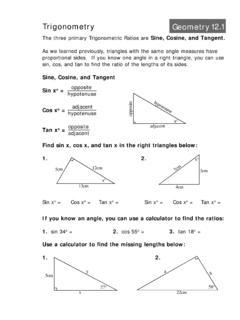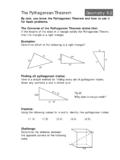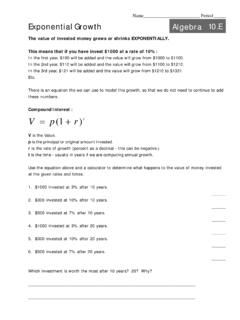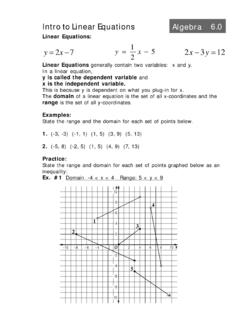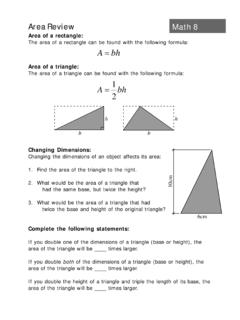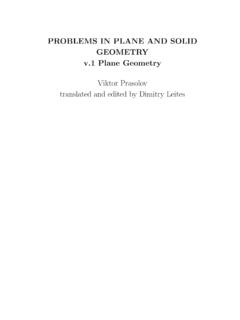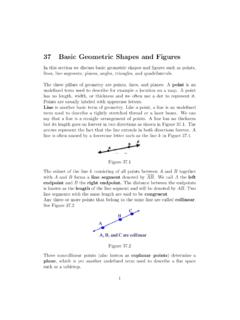Transcription of Triangle Basics Geometry 4 - AGMath.com
1 Triangle Basics Geometry First: Some Basics you should already know. 1. What is the sum of the measures of the angles in a Triangle ? Write the proof (Hint: it involves creating a parallel line.). 2. In an isosceles Triangle , the base angles will always be _____. The proof of this generally involves some information we will review today, but here it is two ways: B Triangle ABC is congruent to Triangle CBA. (side-angle-side) therefore angle A = angle C. D E. Not satisfied? Add some lines: AD = CE. Triangle ABE = Triangle CBD (SAS). Therefore Triangle CAD = ACE (subtraction). A C Which makes angle BAC = BCA. 3. If exactly two angles in a Triangle are equal then it must be _____.
2 (this is the converse of #2). 4. What is the relationship between an exterior angle of a Triangle and the sum of the remote interior angles? Prove with just a sentence or two. A. remote interior angles adjacent interior angle exterior angle B C D. 5. In Triangle XYZ: XY=6inches, YZ=9 nches, and XZ=11 inches. Which is the largest angle: X, Y, or Z? The smallest? 6. Which of the following sets of numbers could NOT represent the three sides of a Triangle ? 3-4-5 5-12-13 8-15-20 16-17-40 10-10-17. 7. How many scalene triangles have sides of integral (integer) length and perimeter less than 15? Name_____ Period _____. Triangle Congruencies Geometry You have probably already heard of most of the Triangle congruence short- cuts.
3 Today we will construct several triangles to demonstrate the shortcuts we can use to show two triangles are congruent. F G F H. G H. G. H. Figures are considered congruent if they are exactly the same. If you can slide, rotate, or reflect one figure so that it is exactly the same as another, the two figures are consid- ered congruent. 1. ___SSS: Side-Side-Side Use the three sides above to construct a Triangle (begin with FH). Compare it to the ones your classmates drew. Does SSS demonstrate congruence? 2. ___SAS: Side-Angle-Side Use FG, angle G and GH to construct a Triangle . Compare it to the Triangle your class- mates drew. Does SAS demonstrate congruence? 3. ___ASA: Angle-Side-Angle Use angle G, segment GH, and angle H to construct a Triangle .
4 Compare it to the Triangle your classmates drew. (Is AAS a congruence shortcut? Why or why not?). 3+. ___AAS: Side-Angle-Angle 4. ___SSA: Side-Side-Angle Use angle G, segment GH, and segment FH to construct a Triangle . Compare it to the Triangle your classmates drew. Does SSA demonstrate congruence? Is it possible to draw more than one Triangle using angle G, segment GH, and segment FH? Name_____ Period _____. Triangle Congruencies Geometry HL and LL congruence: Use the following segments again. F G. G H. 1. ___LL: Leg-Leg (For right triangles.). Construct Right angle FGH. Connect FH. Compare your Triangle to the ones your classmates drew. Which congruence shortcut is this identical to?
5 2. ___HL: Hypotenuse-Leg (For right triangles.). Construct right angle H on segment GH. Use length FG to complete right Triangle FGH. Compare your Triangle to the ones your classmates drew. Is this similar to any of the congruence shortcuts on the opposite side of this page? Using Congruence Shortcuts Geometry Determine which of the following pairs of triangles are congruent and why: Triangles are not necessarily to scale. ~. ABC = ___ by ___. ~. BAC = DEC? A A. 10. 55o 55o B B. C E C E. 55o 10. 55o D. D. BCD ~. = BAC? ~. BAC = CDB? A A. 80o 35o C C. 60o B 35o B. 60o 80o D D. ~. ABC = CDE? CDB ~. = CBD. ~. ACB = ECD? E. E. C D. C 80o 80o A B. A B. D. Using Congruence Shortcuts Geometry Determine which of the following pairs of triangles are congruent and why: Triangles are not necessarily to scale.
6 ~. ABC = ___ by ___. ~. ABC = ADC? A E A. D. C. B. B C D. ~. CBA = CED? ADC ~. = CBA? A D. A B. 30o 61o 4c m E. 89o D C. B 5cm C. ~ C? G is the centroid. A=. AD=CF. A ~. AGF = CGD? ~. ADE = CFE? A. C. F. D. B G. E. D. C. B. Name_____ Period _____. Proof/ Beginning Proof Writing Geometry Mathematical Proof takes an accepted set of facts and properties to demon- strate something to be true. In a two-column proof, statements are made on the left and justifications are made on the right. Ex. E Given: ~. AE DB and ECB = ACD. Prove: C ACD ~. = ECB. A B. D. ~ EC. 1. AC = 1. Given 2. ECB =~ ACD 2. Given 3. AE DB 3. Given 4. ACD = ~ CDB 4. AIA. 5. ECB =~ CBD 5. AIA. 6. CDB = ~ CBD 6.
7 Transitive Property of Congruence 7. CDB is isosceles. 7. Base Angles are Congruent (Converse of Isos. Theorem). 8. CD ~. = CB 8. Definition of Isosceles 9. ACD ~= ECB 9. SAS (1,2,8). Some common justifications you will be using in your proofs: Alternate Interior Angles (AIA). Corresponding Angles (CA). Definition of _____. (midpoint, square, kite, vertical angles, bisector, etc.). SSS, ASA, SAS, SAA, HL, LL. Same Segment or Same Angle (ex. If you said BD ~ = DB. This will later be called the Reflexive Property of Congruence, but that is not necessary now.). Vertical Angles Linear Pair etc. On the back, record any new justifications that we learn so that you can have a list to use when writing proofs.
8 CPCTC Geometry If you can show that two triangles are congruent, then their corre- sponding parts are also congruent. CPCTC: Corresponding Parts of Congruent Triangles are Congruent We will use this shortcut when writing Two-Column Proofs. B D. Given: C is the midpoint of segment AE. AB and CD are parallel. Angle B and Angle D are congruent. Prove: BC=DE. A. C E. In a two column proof, statements are made in the left column, and justifi- cations for those statements are on the right. 1. Begin with the given information. 2. Work through the diagram to determine whether the conclusion can be reached. 3. Organize the steps carefully as in the example below, including the given information.
9 B D. EX. Given: C is the midpoint of segment AE . AB and CD are parallel. Angle B and Angle D are congruent. Prove: BC=DE. A. C E. 1. C is the midpoint of AE. 1. Given 2. AC=CE 2. Definition of midpoint 3. AB and CD are parallel. 3. Given 4. ECD = CAB 4. Corresponding angles 5. B= D 5. Given 6. ABC = ~ CDE 6. SAA congruence (# 2, 4, 5). 7. BC = DE 7. CPCTC. CPCTC Geometry Write a two-column proof for each: Given: Given: AB DC AB = AD. ~ BDA. DBC = AC bisects BAD. Prove: A = C Prove: ACB = 90o A. B A. D. D C. C B. For each problem below, some of the given information is included in the diagram. Given: Given: AB = ED AD BC. CE bisects BCD Prove: AB=CD. Prove: BC=EC.
10 A D. A B. E. D C. B C. A Given: C is the midpoint of BF. F is the midpoint of CE. B F. C E AB DE. A= D. Prove: AF=CD. D. Flowchart Proofs Geometry Flowcharts can be used to explain the logical organization of a proof. In a flowchart proof, statements are placed within boxes, with the justifica- tion below the box. Arrows connect statements. The arrow can be read as the word therefore.. B D Given: ~ EDC. ABC =. C. ~ CEA. CAE =. ~ DCE. Prove: BCA =. A E. CAE =~ CEA ~ EC. AC =. Given Congruent sides of an isosceles BCA =~ DCE ~ DCE. BCA =. Vertical angles AAS. ABC =~ EDC. Given B D Given: ~ DCE. BCA =. C. ~ EBA. Prove: ADE =. This can be done many ways, try to find the easiest.


